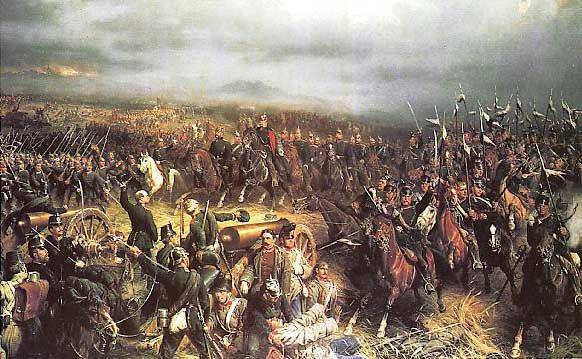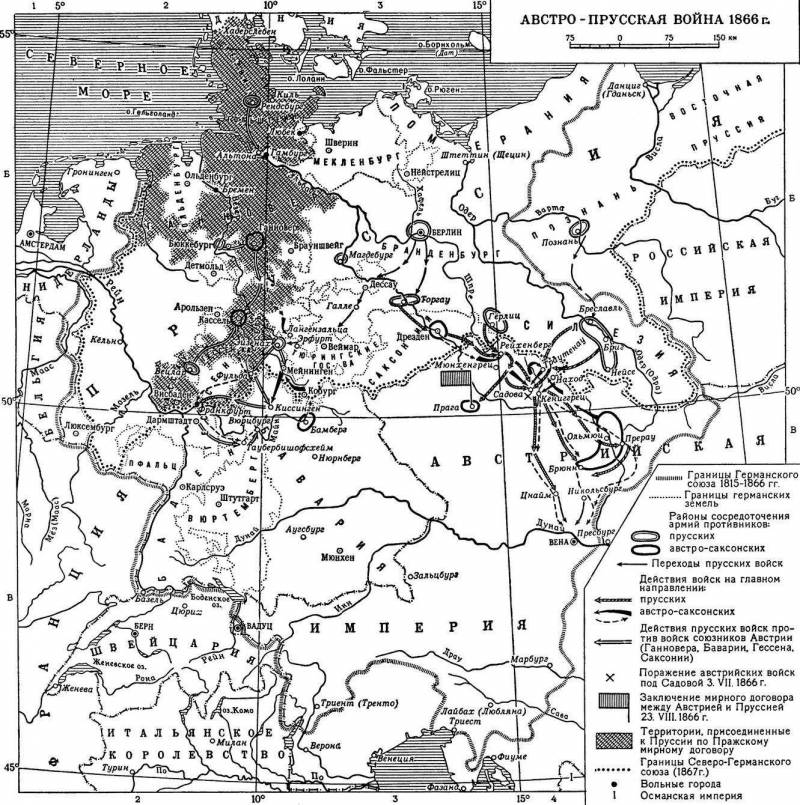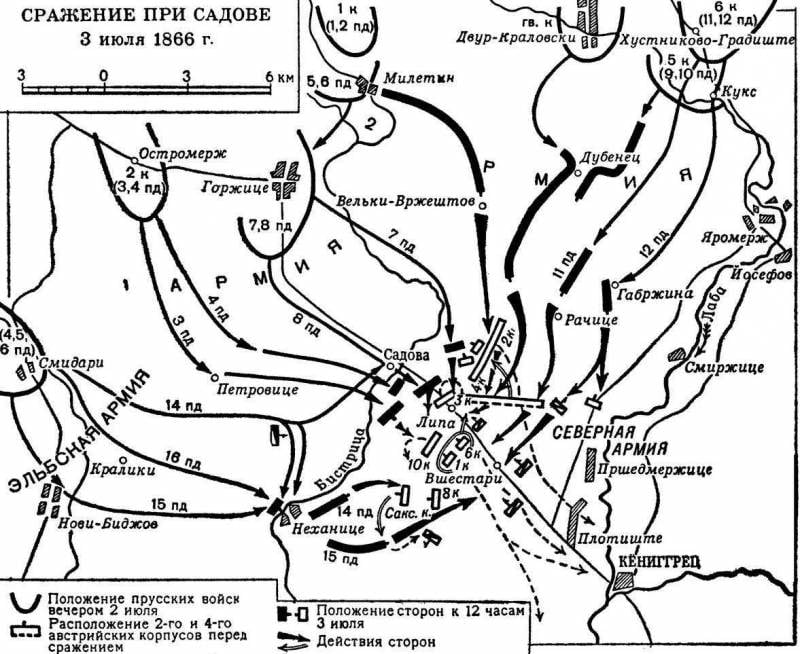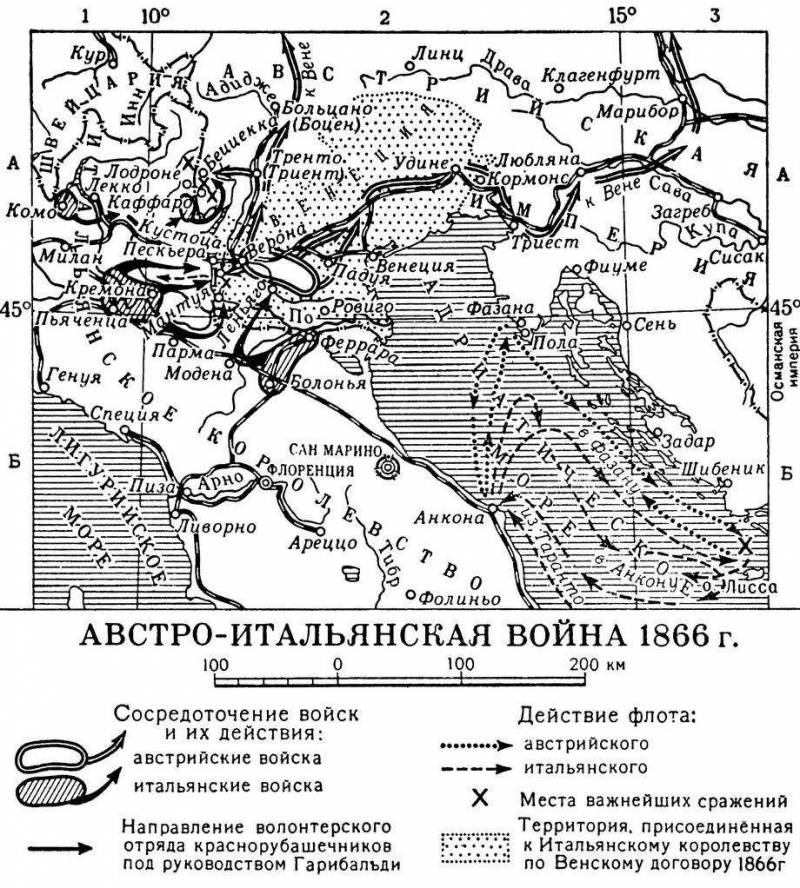"Iron and blood": how Prussia defeated Austria. H. 2
14 June, at the request of Austria, supported by the majority of small German states, the German Union Sejm decided to mobilize four corps - the German Union contingent exhibited by medium and small states. This decision to mobilize was made by Berlin as a declaration of war. Formally, King William I stood at the head of the Prussian army; in fact, the operations were led by the head of the Prussian General Staff Helmut von Moltke. The Austrian Northern Army was commanded by General Ludwig von Benedek, who distinguished himself in the Italian campaigns of 1848-1849 and 1859.
Hostilities between the mobilized Prussians (Prussia began mobilization activities in the spring) and the Austrian allies who did not have time to mobilize began the next day, June 15. As soon as the Austrian Empire began concentrating troops near the borders, Prussian troops under the command of General von Moltke finished concentrating and invaded Bohemia. Only the Saxons managed to mobilize the corps and retreated from Saxony, where Prussian troops invaded, in Bohemia - towards the Austrian army. Thus, the only valuable thing that Vienna received from its allies was the Saxon corps.
The chief of the Prussian General Staff, General H. Moltke Sr., developed a plan of lightning war. Moltke offered to give the future war a bright offensive character, to start military operations without a diplomatic period, not allowing the enemy to mobilize troops and use the complete military unwillingness of the opponents of Prussia. At the very beginning of the war, the Prussians were to occupy the allied fortress of Mainz and disarm the Austrian and allied forces that made up its garrison. At the same time, on the very first day of the mobilization, the Prussian troops had to invade Saxony from different sides, take the Saxon troops unawares and, having finished with them, proceed to full mobilization. Having completed the mobilization, the two armies were to invade Bohemia and defeat the Austrian army before the completion of its concentration.
According to the plan Moltke 16 June 1866, the Prussian troops began to occupy the lands belonging to the German Union - Hanover, Saxony and Hesse. 17 June Austria declared war against Prussia. 20 June The Italian kingdom, fulfilling the terms of the treaty with Prussia, declared war on Austria. Thus, the Austrian Empire had to wage war on two fronts - in the Italian and Bohemian (Czech) theaters. A number of South German states supported Austria, but could not provide it with real assistance.
Austria and Saxony formed the main front against Prussia, putting up thousands of soldiers before 260. Here, naturally, the main forces of the Prussian army were to be deployed. The other theater was represented by Hanover and Hesse, the allies of the Austrians, they could put up to 25 thousands of soldiers. Their possessions were of strategic importance - communications passed through these states that connected the Rhine possessions of Prussia with the main part of its territory. Therefore, Berlin was interested in the speedy defeat of the troops of these German states. The third theater was South Germany, where Prussian opponents could mobilize up to 90-100 thousand people. However, at the beginning of the war, the troops of the South German states were still unmobilized and scattered, and the danger could arise from this side not earlier than July.
Therefore, Moltke decided to risk throwing against Austria the main part of the army, temporarily not deploying troops against South Germany and a barrier against France. Against Hanover and Hesse, he singled out only 3 divisions - 48 thousand soldiers. These troops were to immediately invade Hannover from three sides, surround and force 18-thousand to capitulate. Hannover corps. Given the suddenness of the attack and the qualitative superiority of the Prussians, this was a completely solvable task. Having dealt with Hanover and Hesse, the three Prussian divisions were to turn to South Germany. The remaining 3 divisions from the Rhine and Westphalia Moltke redeployed to the main theater, making up the Elbe army. Moltke divided the two reserve corps (from landver and spare parts), which were supposed to be ready by July: the first was sent to the main theater in readiness for the occupation of Bohemia in the rear of the main forces; the second is against southern Germany.
Austria had to allocate significant forces (about 140 thousand people) to the Italian theater, while Bavaria, allied with Austria, refused to send its troops to Bohemia. As a result, the Prussians received a small numerical superiority in the Bohemian theater - 278 thousand soldiers against about 261 thousand people who made up the Northern Austrian army (including the Saxon Corps retreated to Bohemia).
Prussia had a military industrial and technical superiority over the enemy. Prussia was superior to Austria in industrial development; Prussia’s relatively dense rail network provided rapid mobilization and strategic deployment. The Prussian infantry was armed with needle-like ones that were loaded from the breech part of the Dreyse system gun, whose rate of fire was 3 times higher than the Austrian guns charged from the barrel. The Austrians who failed to adapt their tactics to the new rifle arms, applied by the Prussians, suffered great losses. A serious weakness of the Austrian army was the lack of national unity. In particular, the Hungarians did not want to fight and easily surrendered to captivity. Part of the Hungarian elite served as the "fifth column" of Prussia, taking the course of a national uprising. Only the rapid end of the war saved the Austrian Empire from an internal, civil war. However, after the war ended, Vienna had to make serious concessions to the Hungarians. Also, many deserters were among the Italian nationals of Austria and Romanians.
Source cards: http://dic.academic.ru/
Milestones
At the Main Theater, in Hanover, Hesse, and then in the Frankfurt area, Prussian troops quickly achieved success. 28 June Hanover capitulated at Langensalza, after which the Prussians were able to force offensive actions against the Austrians and Saxons in Bohemia. Strategic deployment against Saxony and Austria was carried out in an arc of over 10 km of 250 by three armies: The 2 army under the command of crown prince Friedrich Wilhelm was located in Silesia - between the cities of Breslavl (Wroclaw) and Neisse (Nyisa); The 1 Army of Prince Friedrich Charles in the Görlitz region (in Lausitz) and the Elbe Army of General Herwart von Bittenfeld in the Torgau region. Subsequently, the Elbe army was subordinated to Frederick Karl. The main forces of the Austrian Northern Army, concentrated first in the fortified area Olmütz (Olomouc), then moved to Bohemia, to the fortress area of Josefstadt (Jaroměř) and Königgrätz (Hradec Králové).
The Prussian High Command gave 22 Jun a directive on a concentric invasion of Bohemia, so that the two main groupings would unite in the Gichin area. In almost all the clashes, the Prussian troops were successful: the 2-I Prussian army scored upwards at Nachod (June 27), Skalitz and Burkersdorf (June 28), and Koniginhof (June 29); The 1 Army is at Munich (June 28), Gichina (June 29).
On July 3, a decisive battle took place in the Sadova-Königgrets area, in which approximately equal forces participated on both sides - 220 thousand Prussians with 924 guns, 215 thousand Austrians (including 30 thousand Saxon corps) with 770 guns. The Austrian army, under the command of General Benedek, after exhausting marches and oncoming fights, 1 July took up a position at heights to the east of the r. Bystritsa front to the west, bending the right wing to the river. Elbe. Thus, the Austrians occupied an extremely disadvantageous position between the rivers Bistrica and Elba. The Austrian army, compressed between these two rivers, turned out on the night of 3 July before the semiring of three Prussian armies: Elbe in the west (threatened the left flank of the Austrians), 1 in the northwest (in front of the center) and 2 in the Silesian army at a distance in the north (hung over the right flank of the Austrians by the Elbe River). The Prussians were able to surround the enemy with flank envelopes of the Elbe and 2 armies.
The Prussian command, which did not expect to meet the entire army of the enemy, and fearing a powerful frontal attack by the Austrians, decided to act ahead of the curve and tie up the army of Benedek with an attack on the front, until the Elbe army from the south, and the 2-I army from the north would cover Austro-Saxon army . July 3 early in the morning The 1 th Prussian army of Frederick Karl (84 thousand soldiers) attacked the center of the Austrian position north and south of Sadovy. At the same time, the Elbe army of General Herwart von Bittenfeld (about 5 thousand people) launched an offensive in 8-40 km south of Sadovy (about XNUMX thousand people), bypassing the left flank of the Austrians. Persistent battles with varying success ensued. The vanguard of the Elbe army pressed the Saxons, who were supported by the Austrians. However, two Prussian divisions could not cover the left flank of the Austrian army.
In the center four, and then six Prussian divisions attacked the enemy’s positions along the river Bistrica. The advanced positions of the Austrians were captured. The Prussians occupied the village of Sadov, began to force Bystritsa. There, in the forest, Prussian troops were concentrated for a decisive throw on the main positions of the Austrians at the heights of sec. Linden. However, the effective fire of the Austrian artillery restrained the Prussian attack and inflicted heavy losses on the Prussians. By noon, the six Prussian divisions in the center and three divisions of the Elbe army on the right flank could not overturn the enemy. The Austrians not only held, but also decided to counterattack. The 4 th and 2 th Austrian corps inflicted a counterstrike and overturned the 7 th Prussian division of General Franzetsky. However, the Austrians no longer had time for more: the 2-I Prussian army, with its four corps, already hung over the right flank and rear of the Benedek army.
Happy Austrians attacked 2-I Prussian army Crown Prince Frederick William. This blow to the flank and rear of the Austrian army decided the outcome of the battle. General Benedek was forced to interrupt the launched counterattack, to delay and bend his right flank. Meanwhile, the Elbe army part of the forces bypassed the left flank of the Austrians, and the 1-I and 2-I armies continued to put pressure on the center, right flank and rear. Under the threat of encirclement, General Benedek began to withdraw his troops under the cover of an artillery group located in 4 km north-west of Königgrets. Soon, a poorly organized retreat in the limited interfluve space turned into an irregular flight. The Austrians were saved only by the fact that the Prussians did not organize a vigorous pursuit that could lead to the complete destruction of the Austrian army.
Thus, the Prussians achieved major success, forcing the Austrians to a disorderly retreat. The loss of the Austrians killed, wounded and captured amounted to over 44 thousand people. The loss of the Prussian army amounted to more than 9 thousand people. In the battle of Sadov (in German and Austrian literature - the battle of Königgrätz), the superiority of the Prussian weapons (Dreyze’s needle guns) and strategies - the attack by separate groups on a broad front, their convergence on the march and a concentric attack from various sides were revealed. This experience became the basis of the Prussian-German military art, and then was successfully used in the wars of the XX century. However, the Prussian command was not able to organize full-fledged cooperation of the armies and to achieve complete encirclement of the enemy, and prosecution was not organized either. This enabled the Austro-Saxon troops to successfully withdraw.
Benedek withdrew his remaining troops to Olmutsu, defending the Hungarian direction, providing only a small cover for the Vienna direction. The Prussian command resumed the offensive: the 2 army - on Olmutz (to create a barrier), the 1 and Elbe armies - in the general direction to Vienna. In the state of emergency created for Austria, the transfer of Austrian troops from Italy to the north began. Benedek 13 July was replaced by the Archduke Albrecht. The Austrian Empire still had opportunities to organize repulse to the enemy on the outskirts of Vienna and Presburg. However, the internally unstable situation in the empire, especially the threat of secession of Hungary - the Prussian troops soon came close to Presbourg, threatening to cut off Austria from Hungary, which led to the Hungarian uprising against Austrian rule, forced the Austrian government to enter into peace negotiations with Prussia. This Bismarck and sought. It was a victory with little blood.

Battle of Königgrätz German painter Christian Söll
Italian front
As a result of the Austro-Italian-French war of the 1859 of the year and the revolution of 1859-1860, Italy was largely united. However, the Venetian region, which was under the domination of the Austrians, and Rome, which was under the authority of the pope and under the auspices of France, remained outside the Italian kingdom. In addition, the Italians claimed Trieste, Trentino and South Tyrol. The Savoy dynasty, which ruled in Italy, sought to complete the unification of the country, to which the national interests and the patriotic public were pushing it. Therefore, Italy went to an alliance with Prussia.
The Prussian military commissioner, General Berngardi, and the Prussian envoy persuaded the Italian leadership to begin the war in the most active way: to ferry the main mass of troops through the lower course of the r. By and push it to Padua, in the rear of the Austrian army concentrated in the "quadrilateral fortresses" (Mantua, Peschiera, Verona, Legnago); then begin a vigorous offensive into the inner regions of Austria — against Vienna; to transfer Garibaldi and his volunteers across the Adriatic Sea to support the Hungarian uprising; to take part in the organization of the uprising in Hungary and thereby "strike a blow to the Austrian state". However, Italy was not ready for an active offensive campaign.
The Italian government in advance began to push troops from the southern part of the peninsula and Sicily. Nominally, the Italian army was commanded by King Victor Emmanuel II. 20 June 1866 y. 250 thousand. The Italian army under the command of Alfonso Ferrero Lamarmore invaded the Venetian region, which was defended by the 140-thousand. Austrian army under the authority of Prince Albrecht of Austria.
The main Italian army of 23 on June 1866 of the year began to force the river Mincho and had to penetrate into the “quadrilateral fortress” occupied by the Austrians (Mantua, Verona, Peschiera, Legnago). The army consisted of three corps, each of the 4's infantry and one cavalry divisions, and one separate cavalry division. The second Italian army in the 2-x corps under the command of General Cialdini was sent around the "quadrilateral fortress" to the lower course of the river Po. The Austrian commander Archduke Albrecht, following the plan drawn up by his chief of staff, General Jon, leaving insignificant cavalry forces to observe Po and one brigade to protect the rear, concentrated the main forces at Verona. The Austrian army consisted of three infantry corps, one reserve and one cavalry divisions.
The Italian offensive ended in defeat. June 24 main 125-th. the Italian army under the command of General Lamarmora suffered a heavy defeat from the 75-thousand. the Austrian army in the Battle of Kustots, losing 7 thousand people killed and wounded and 3 thousand prisoners. Austrian cavalry defeated the Italians' right flank (two divisions of the 3 Corps). The Austrian reserve division, knocking over the 1 division, which was on the left flank of the 1 Italian Corps, broke through to the crossings over the Mincho. Here she was thrown back by the 2 Division, which, however, did not dare to counterattack and bypass the right flank of the Austrian army. Then, during a stubborn battle in the center, when the village of Custots passed from hand to hand several times, the 5, 7, and 9 Austrian corps forced the enemy to retreat. Lamarmor lost control of the troops and rushed to the rear to bring the reserve. But both reserve divisions were detained by fleeing wagons and never appeared on the battlefield. True, the Austrians were tired and suffered significant losses (5-6 thousand people), so they did not pursue the defeated enemy. As a result, the Italian army freely moved to the right bank of the Mincio.
Thus, the dispersion of forces, poor organization, poor quality of infantry and cavalry, inability to use artillery, led the more numerous Italian army to defeat. The Austrians won on the main line, but neither this victory nor the success in the naval battle at Liss (July 20) played a decisive role, since the main front was in the north. The defeat of the Austrians in the Battle of Sadow from the Prussians restored the fighting spirit of the Italians. July 8 Italians again went on the offensive. In addition, the corps of J. Garibaldi gained victories and quickly moved to South Tyrol. As a result, when Prussia forced Austria to capitulate, Italy became the winner and received the coveted Venice.
With the mediation of Napoleon III on July 26, Prussia, without prior agreement with Italy, concluded an armistice with Austria. The Savoy dynasty agreed to a truce dictated by Napoleon III and Bismarck (a truce between Italy and Austria was concluded on August 10). 3 October 1866 in Vienna a peace treaty was concluded, under which Austria ceded the Venetian region to the French emperor Napoleon III, and he transferred it to the Italian kingdom. October 21 A plebiscite was held in the Venice Region, according to which this area was incorporated into Italy. Trieste, Trentino and South Tyrol, liberated by Garibaldi's troops, Austria retained until the end of the First World War.
Results
Fearing intervention in the French war, Russia's discontent, and counting on rapprochement with Austria in the future, Bismarck, despite the resistance of King William and the Prussian generals, who "tasted blood" and wanted to finish off the Habsburg empire, insisted on the rapid cessation of hostilities and preserving the territorial integrity of the Austrian empire
On July 26, a preliminary peace was signed in Nicholsburg, and a peace treaty was signed in Prague on August 23. As a result, Austria escaped with minor territorial and material losses, but suffered historical defeat in the struggle against Prussia for Germany. The main result of the war was the dissolution of the German Union, where Austria dominated, and the formation of the North German Union under the leadership of Prussia. The North German Union became the core of the future German Empire (Second Reich), which Bismarck would create after the defeat of France. Weakened Austria remained outside the union and could no longer interfere with Bismarck's policy of unifying Germany. Bismarck could begin the final stage of creating an empire - the defeat of France.
Austria refused in favor of Prussia from all its rights to Schleswig and Holstein. Vienna paid Berlin a contribution to 20 million Prussian thalers. The Venetian region was ceded to Italy. Italy was not completely satisfied with this acquisition, which became the basis for the entry of the Italian kingdom into the Entente during the First World War.



Information